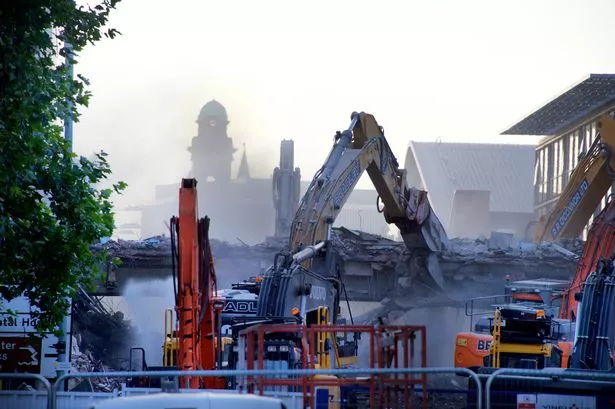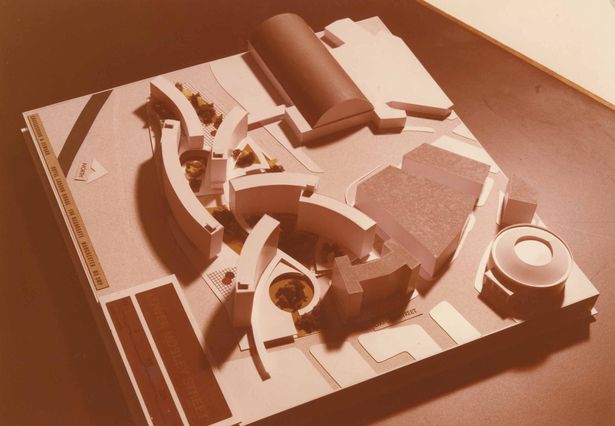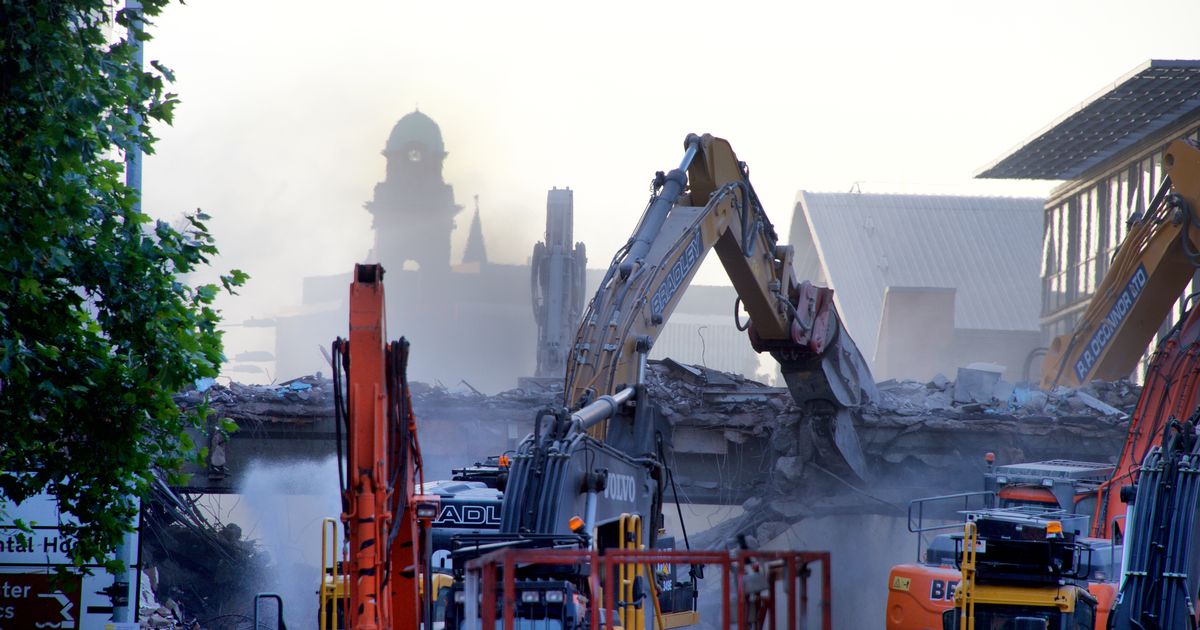it’s been 10 years since the city’s iconic Oxford Road footbridge was reduced to rubble Demolition of Oxford Road footbridge (Image: Jill Jennings)
Demolition of Oxford Road footbridge (Image: Jill Jennings)
It’s been a decade since one of the last surviving pieces of a 1960s dream for Manchester came crashing down. Manchester University’s Oxford Road footbridge had been an iconic landmark in the city since it opened in 1969.
Part of the university’s Oxford Road precinct, it was once the centrepiece of a much grander vision for the city. The footbridge was part of a bizarre utopian vision dreamt up for Manchester 50 years ago, which would have seen vast swathes of the city connected by ‘walkways in the sky’.
In the 1960s, university planners, impressed by the expansion of American freeways, wanted a series of interlinking pedestrian bridges all the way to Oxford Road station and out as far as Hulme and Ardwick. They hoped it would not only elevate people above the growing traffic, but also ensure ‘town met gown’ by encouraging academics to mix with the rest of the city.
The bridges would have connected virtually all modern buildings along the Oxford Road corridor at first-floor level and run out towards the university’s Sackville Street campus.
Join the Manchester Evening News WhatsApp group HERE
The precinct centre would have been the hub for all the walkways, containing a shopping area researchers liken to a purpose-built town centre.
Bridges would have criss-crossed Oxford Road at several points, including at what is now the Aquatics Centre, connecting to raised walkways that would extend at least as far as Oxford Road station.
 The iconic pedestrian footbridge over Oxford Road
The iconic pedestrian footbridge over Oxford Road
Further walkways would have run out from the university precinct towards Upper Brook Street in one direction and to Hulme in the other.
The vision would also have tied into separate plans in the late 1960s for a monorail system – a light rail line running down Oxford Road, which would have had a stop at the university’s Stopford Building.
It also assumes that Grafton Street, next to the hospital, would become a major arterial route – as was being discussed at the time.
However, the university’s vision never materialised for a host of reasons, not least because of the 1970s economic climate.
As nearby MMU was developed separately, different transport plans unfolded, and the fashion for such projects waned, the precinct ended up marooned on Oxford Road.
 Model shows raised pedestrian bridges across Oxford Street and Lower Mosley Road(Image: Cruickshank and Seward archive at Manchester Metropolitan University Museum)
Model shows raised pedestrian bridges across Oxford Street and Lower Mosley Road(Image: Cruickshank and Seward archive at Manchester Metropolitan University Museum)
Speaking to the Manchester Evening News in 2015, Dr James Hopkins, a historian at Manchester University, said it was one of the great ‘failed visions’ of its time.
“It became very vogue to assume that Britain and Europe were going to follow an American transport model with all those big freeways,” he said.
“The idea was that there would be the precinct centre with the bridge across the road, with the shopping area inside. That would become like a mini town centre, which would be where all these bridges would intersect – linking the university to the south, to the Royal Northern College of Music, but also going out into the Sackville Street campus, Hulme and Ardwick.”
Other universities had similar plans, he said, but added: “None of them were as ambitious as the Manchester one. This was trying to impose a grand vision on a 19th-century city. It was one of those plans that just kind of petered out and died.
“All of a sudden you have this precinct centre marooned in all these buildings with ground floor entrances. You were supposed to look over the traffic going by on Oxford Road – but it always just looked a bit sad.”
Remarkable time lapse video of demolition of Oxford Road footbridgeContent cannot be displayed without consent
The demolition of the Oxford Road footbridge in August 2015 was a symbolic end to this ‘failed vision’.
The decision to tear down the bridge was made as part of Manchester University’s £50 million redevelopment of the Manchester Business School.
Part of the busy Oxford Road corridor was closed for a month as workmen reduced one of the last remnants of Manchester’s 1960s dream of ‘walkways in the sky’ to dust.
Love Greater Manchester’s past? Sign up to our nostalgia newsletter here
